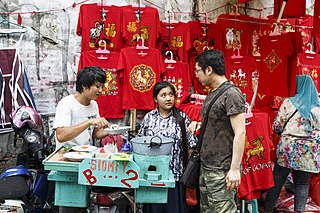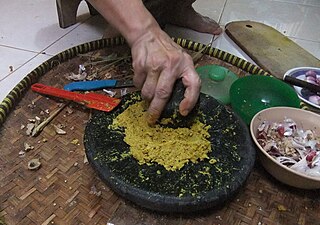
Chinese Indonesian cuisine is characterized by the mixture of Chinese with local Indonesian style. Chinese Indonesians, mostly descendant of Han ethnic Hokkien and Hakka speakers, brought their legacy of Chinese cuisine, and modified some of the dishes with the addition of Indonesian ingredients, such as kecap manis, palm sugar, peanut sauce, chili, santan and local spices to form a hybrid Chinese-Indonesian cuisine. Some of the dishes and cakes share the same style as in Malaysia and Singapore, known as Nyonya cuisine by the Peranakan.

Nasi goreng, Malay lit. 'fried rice', is a Southeast Asian rice dish with pieces of meat and vegetables added. It can refer simply to fried pre-cooked rice, a meal including stir fried rice in a small amount of cooking oil or margarine, typically spiced with kecap manis, shallot, garlic, ground shrimp paste, tamarind and chilli and accompanied by other ingredients, particularly egg, chicken and prawns. There is also another kind of nasi goreng which is made with ikan asin which is also popular across Indonesia. Nasi goreng is sometimes described as Indonesian stir-fried rice, although it is also popular in Southeast Asia. Beyond the Malay Archipelago, it has gained popularity through Indonesian influence in Sri Lanka and via Indonesian immigrant communities in Suriname and the Netherlands. It is distinguished from other Asian fried rice recipes by its aromatic, earthy and smoky flavor, owed to generous amount of caramelised sweet soy sauce and powdered shrimp paste, and the taste is stronger and spicier compared to Chinese fried rice.

Bakmi or bami is a type of wheat-based noodles derived from Chinese cooking tradition. It was brought to Indonesia by Chinese immigrants from Southern Chinese provinces like Fujian. It is typically prepared seasoned in soy sauce and topped with pork products, which is often substituted for other protein sources in predominantly Muslim Indonesia. Chinese-style wheat noodles has become one of the most common noodle dishes, especially in Southeast Asian countries which have significant Chinese populations and known by various names.

Mie goreng, also known as bakmi goreng, is an Indonesian stir-fried noodle dish. It is made with thin yellow noodles stir-fried in cooking oil with garlic, onion or shallots, fried prawn, chicken, beef, or sliced bakso (meatballs), chili, Chinese cabbage, cabbages, tomatoes, egg, and other vegetables. Ubiquitous in Indonesia, it is sold by food vendors from street hawkers (warungs) to high-end restaurants.

Bakso or baso is an Indonesian meatball, or a meat paste made from beef surimi. Its texture is similar to the Chinese beef ball, fish ball, or pork ball. The word bakso may refer to a single meatball or the complete dish of meatball soup. Mie bakso refers to bakso served with yellow noodles and rice vermicelli, while bakso kuah refers to bakso soup served without noodles.

Javanese cuisine is the cuisine of Javanese people, a major ethnic group in Indonesia, more precisely the province of Central Java, Yogyakarta and East Java.

Soto mie, Soto mi, or Mee soto is a spicy Indonesian noodle soup dish commonly found in Indonesia, Malaysia, and Singapore. Mie means noodle made of flour, salt and egg, while soto refers to Indonesian soup. In Indonesia, it is called soto mie and is considered one variant of soto, while in Malaysia and Singapore it is called mee soto.

Kwetiau goreng is an Indonesian style of stir fried flat rice noodle dish. It is made from noodles, locally known as kwetiau, which are stir-fried in cooking oil with garlic, onion or shallots, beef, chicken, fried prawn, crab or sliced bakso (meatballs), chili, Chinese cabbage, cabbages, tomatoes, egg, and other vegetables with an ample amount of kecap manis. In Asia, kwetiau is available in two forms, dried and fresh. Its recipe is quite similar to another Chinese Indonesian favourite, mie goreng, with the exception of replacing yellow wheat noodles for flat rice noodles.

Bumbu is the Indonesian word for a blend of spices and for pastes and it commonly appears in the names of spice mixtures, sauces and seasoning pastes. The official Indonesian language dictionary describes bumbu as "various types of herbs and plants that have a pleasant aroma and flavour — such as ginger, turmeric, galangal, nutmeg and pepper — used to enhance the flavour of the food."

Mie koclok, is an Indonesian chicken noodle soup, a specialty of Cirebon city, West Java. The noodles come with a white-colored extra-thick porridge-like soup, made of chicken broth and coconut milk soup, which is coagulated with corn starch or tapioca. Other ingredients include shredded chicken breast, cabbage, bean sprouts, hard boiled egg, kaffir lime juice, and sprinkled with sliced fresh celery, spring onion, and fried shallot.

Mie kangkung, is an Indonesian vegetable noodle soup with kangkung, usually served with bakso meatball and mushroom. It is a specialty of Betawi cuisine, Jakarta, Indonesia. The yellow egg noodles come with a brown-colored thick soup, made of chicken or beef broth, which is thickened with tapioca, spiced, and mixed with garlic and kecap manis. Other ingredients include bakso meatballs, bean sprouts, mushrooms, hard-boiled quail eggs and sprinkled with bawang goreng and added with a dash of kaffir lime juice and sambal.

Lumpia are various types of spring rolls from China, Indonesia, and the Philippines. Lumpias are made of thin paper-like or crepe-like pastry skin called "lumpia wrapper" enveloping savory or sweet fillings. It is often served as an appetizer or snack, and might be served deep-fried or fresh (unfried). Lumpia are Indonesian and Filipino adaptations of the Fujianese rùnbǐng and Teochew popiah, usually consumed during Qingming Festival.

Soto is a traditional Indonesian soup mainly composed of broth, meat, and vegetables. Many traditional soups are called soto, whereas foreign and Western influenced soups are called sop.

Beef kway teow or beef kwetiau is a Maritime Southeast Asian dish of flat rice noodles stir-fried and topped with slices of beef or sometimes beef offal, served either dry or with soup. The dish is commonly found in Southeast Asian countries, especially Singapore and Indonesia, and can trace its origin to Chinese tradition. It is a popular dish in Singaporean cuisine and among Chinese Indonesians, where it locally known in Indonesian as kwetiau sapi.

Mie jawa, also called as mi jawa or bakmi jawa in Indonesia, or mee Jawa in Malaysia is a traditional Javanese style noodle, commonly found in Indonesia and Malaysia. The dish is made of yellow noodle, chicken, vegetables, egg and spices. The recipe however, is slightly different between mie jawa in Indonesia and mee Jawa in Malaysia.

Kwetiau ayam, kuetiau ayam or sometimes kwetiau ayam kuah is a common Chinese Indonesian dish of seasoned flat rice noodles topped with diced chicken meat. It is often described as a kwetiau version of the popular mie ayam, and especially common in Indonesia, and can trace its origin to Chinese cuisine.

Indonesian noodles are a significant aspect of Indonesian cuisine which is itself very diverse. Indonesian cuisine recognizes many types of noodles, with each region of the country often developing its own distinct recipes.

Bihun goreng, bee hoon goreng or mee hoon goreng refers to a dish of fried noodles cooked with rice vermicelli in both the Indonesian and Malay languages. In certain countries, such as Singapore, the term goreng is occasionally substituted with its English equivalent for the name of the dish.






















